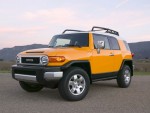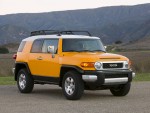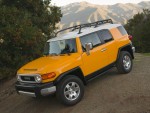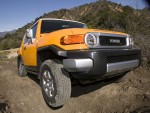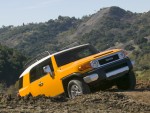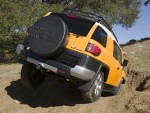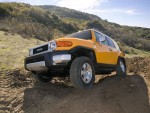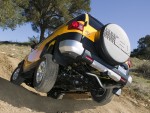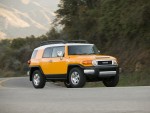2009 Toyota FJ Cruiser
2009 Toyota FJ Cruiser Pictures & Specifications
Home »
Toyota
Picture Gallery
Technical Specifications
Model: FJ Cruiser (US specification)
Engine: 4.0-litre V6
Aspiration: Natural
Power: 239 hp (178 kW)
Torque: 278 lb-ft (376 Nm)
Power per litre: 59.8 hp (44.5 kW)
Torque per litre: 69.5 lb-ft (94 Nm)
Transmission: Six-speed manual or five-speed automatic
Drivetrain: Four-wheel drive
Length: 183.9 in (4671 mm)
Width: 74.6 in (1895 mm)
Height: 72.0 in (1829 mm)
Wheelbase: 105.9 in (2690 mm)
Kerb weight: 4290 lb (1950 kg)
0-62 mph (0-100 km/h): –
1/4 mile (0-400 metres): –
Top speed: –
2009 Toyota FJ Cruiser
Toyota Press Release
10 September 2008
The Toyota FJ Cruiser, which melds the brand’s off-road legacy with distinct heritage design in a modern SUV, gains new safety features and three new colours for 2009.
The 2009 FJ Cruiser gains a roll sensing side curtain airbags, as well as active headrests for the front seats. In certain rear collisions, a cable-actuated mechanism in the active headrest moves the headrest upward and forward to help limit the movement of the occupant’s head. The roll sensing side curtain airbags can detect a potential rollover and signal the Vehicle Stability Control (VSC) system to help reduce a lateral skid. In addition, the rollover sense can signal the standard seat-mounted side airbags and side curtain airbags to deploy.
New for 2009, the optional Convenience Package adds a rear backup camera and auto-dimming rear-view mirror. Three new exterior colours include Black, Silver Fresco Metallic, and Iceberg (white).
Performance and Efficiency
The FJ Cruiser is powered by a DOHC 4.0-litre V6 engine that produces 239 horsepower and 278 lb-ft of peak torque. A Variable Valve Timing with intelligence (VVT-i) system ensures a broad torque curve for easy cruising on or off-road. The V6 offers a pleasing exhaust note, while special sound-absorbing material under the engine cover helps keep the cabin quiet. The FJ Cruiser meets the stringent LEV II/Tier 2 Bin 5 emissions certification.
The FJ Cruiser 4×4 offers a choice between an electronically shifted five-speed automatic transmission and a six-speed manual transmission; the 4×2 model is equipped exclusively with a 5-speed automatic transmission. The automatic varies the transmission’s shifting pattern based on road conditions and driver input. A Flex Lock-Up feature allows the clutch in the torque converter to maintain a half-engaged position, enhancing fuel efficiency and increasing the lock-up clutch’s operational range. The driver can manually shift the automatic transmission using a console-mounted, gate-type shift lever. The gearshift position is also displayed in the instrument panel.
The FJ Cruiser’s two-speed transfer case (with a 2.566 low range) is the same full-time four-wheel-drive transfer case used in the V6-powered 4×4 Toyota 4Runner. In manual-transmission models, the transfer case uses a TORSEN limited-slip center differential with a locking feature and distributes the engine’s power 40:60 under most driving conditions. The TORSEN unit varies power distribution as needed, based on steering angle and wheel slippage. In the Lock position, the differential switches to 50:50 power distribution.
The 4×4 FJ Cruiser with the automatic-transmission employs a part-time four-wheel drive system with a 3.727:1 rear differential ratio and provides a 33.76:1 crawl ratio. With the manual transmission, the front and rear differential ratio is a lower 3.909:1 for a crawl ratio of 41.84:1, an attribute that helped the FJ Cruiser traverse California’s famed Rubicon Trail.
An electronic locking rear differential with an eight-inch ring gear is available. The ring gear in the 4×4 FJ Cruiser’s front differential also measures eight inches. The 4×2 model comes standard with a virtual automatic limited-slip differential, provided and operated by an advanced traction-control system to enhance traction of both rear wheels in slippery driving conditions.
Capability, Handling and Ride
The FJ Cruiser’s tough, wide stance is based around a frame and front-and-rear suspension systems adapted from those found on the Toyota 120-Series Prado (Land Cruiser Prado in some markets). The frame is a boxed steel ladder-braced unit to which the FJ Cruiser’s welded steel body is mounted. Double-wishbone independent front suspension offers 7.87 inches of wheel travel for outstanding suspension articulation. Its geometry is adapted for excellent road feel and ride comfort.
The solid rear axle uses a four-link coil-spring suspension system with a lateral rod, tubular shock absorbers, and a stabiliser bar. This system provides 9.1 inches of wheel travel. The disc-brake system uses ventilated 12.6-inch front and 12.3-inch rear rotors. The FJ Cruiser employs a variable-ratio, hydraulically assisted rack-and-pinion steering system. Standard wheels are 17-inch steel, with 17-inch, six-spoke aluminium wheels available as an option.
With the FJ Cruiser’s standard 32-inch tyres, ground clearance is 9.6 inches (8.7 inches for 4×2 models). Approach and departure angles are 34 degrees/30 degrees for the 4×4 FJ Cruiser and 32/29 for the 4×2 model. Maximum towing capacity with the optional Class Four receiver hitch is 5,000 pounds.
The optional Off-Road Package prepares the FJ Cruiser for demanding off-pavement driving and includes unique 16-inch alloy wheels with 265/75R16 BFG Rugged Trail tyres, trail-tuned Bilstein shock absorbers, a cyclone pre-air cleaner, and a rear differential lock that works in conjunction with the active traction control (A-TRAC) system.
Safety
The FJ Cruiser provides a comprehensive standard safety package, including the standard front seat-mounted side airbags and first- and second-row roll sensing side curtain airbags. Dual-stage front driver and passenger advanced airbags inflate based on impact type and severity. Additionally, the FJ Cruiser provides the LATCH child-restraint system.
As with all Toyota SUVs, the FJ Cruiser is equipped as standard with Toyota’s STAR Safety System™ that includes VSC, Traction Control (TRAC), an Antilock Brake System (ABS), Electronic Brake-force Distribution (EBD) and Brake Assist (BA).
Four-channel, four-sensor ABS helps preserve steering ability by preventing the wheels from locking under hard braking. EBD distributes appropriate braking force between the front and rear wheels according to driving conditions. TRAC helps reduce tyre slippage in slippery or challenging driving conditions. The VSC system helps keep the FJ Cruiser on the driver’s intended course by detecting front- and/or rear-wheel slide during cornering and attempting to control slide conditions via torque intervention and/or braking of individual wheels.
Comfort and Convenience
The FJ Cruiser comes with a long list of standard features, including: 17-inch black steel wheels with P265/70 R17 tyres; air conditioning; power windows and door locks; black water-resistant seats; tilt steering wheel; four cup holders and two bottle holders; rear-window defogger; skid plates for the engine, transfer case and fuel-tank; rear-door-mounted full-size spare tyre; front and rear tow hooks, and mudguards.
Three audio systems are available for the FJ Cruiser. An AM/FM/CD system with six speakers is standard. A pair of NXT SurfaceSound transducers convert the vehicle’s ceiling into a speaker diaphragm (the FJ Cruiser was the first vehicle to use this audio technology). The ceiling transducers complement the conventional speakers elsewhere in the vehicle, creating broad, omni-directional sound dispersion.
Options
A Premium Audio FJammer AM/FM eight-speaker system with an in-dash six-disc CD changer is available as part of an option package, and an amplified subwoofer can be added, located in the right-side panel of the rear cargo compartment. An auxiliary jack also is located in the lower-center switch cluster to provide input for portable audio devices, including iPods and MP3 players, and a 12-volt DC accessory socket is provided to power those devices.
An available Convenience Package includes keyless entry; cruise control; power side-view mirrors with image lights; daytime running lights; privacy glass; rear window wiper; and rear parking sonar. New for 2009, this package also includes a rear backup camera and an auto-dimming rear-view mirror.
Upgrade Package One (which requires the Convenience Package) includes a highly capable active off-road traction-control system; rear locking differential; multi-information display (compass, inclinometer and temperature gauge); Premium Audio system with in-dash six-disc changer, equaliser and eight speakers; a 400-watt inverter; 17-inch alloy wheels; leather-covered steering wheel with integral audio controls and cruise-control function; metal-coloured shift lever; and interior door-trim inserts keyed to the vehicle’s exterior colour. Upgrade Package Two adds the rear subwoofer. Standalone options include 17-inch alloy wheels, a rear locking differential, and running boards.
The customer can personalise the FJ Cruiser by choosing from a catalogue of available accessories, including: auxiliary driving lights, rock rails, roof rack, brush guard, taillight guards, sport exhaust system, receiver hitch and harness, wind deflector with off-road lights, a cargo mat, and all-weather or carpeted floor mats.
Exterior Design
With styling cues reminiscent of Toyota’s famed FJ40 4×4 utility vehicle, sold in the U.S. from 1960 to 1983, the FJ Cruiser offers a youthful, contemporary spirit. At the same time, this unique model and employs the same state-of-the-art, power, comfort, safety and convenience technology available in all Toyota SUVs. The original FJ40, which during its production life served around the world as the safari and expedition vehicle of choice, is today a sought-after collectable.
The five-passenger FJ Cruiser was initially designed as a concept vehicle at Toyota’s Calty Design Research in Newport Beach, Calif. Heritage design features include the front grille with two round, five-inch headlights, reminiscent of the FJ40’s frontal styling; the hood and fender contours; and a rear-mounted and exposed full-size spare tyre with an off-center license-plate-mounting location.
Unlike anything ever seen on the classic FJ40, the FJ Cruiser uses side access doors that open 90 degrees in clamshell fashion for easy rear-seat ingress and egress.
Additionally, a swing-up glass hatch is incorporated into the side-hinged rear door. The glass hatch opens independently of the rear door and helps accommodate longer items such as lumber or surfboards.
The angular wheel arches open to provide maximum clearance for the FJ Cruiser’s large 32-inch tyres at full suspension deflection. The arches are edged by flexible fender flares that resist damage during vigorous off-road driving and also resist damage from the opening doors of other parked vehicles. The FJ Cruiser uses three wiper arms to provide nearly complete coverage of the wide windshield.
Interior Design
The FJ Cruiser’s interior combines heritage-inspired design with the comfort and convenience of a modern Toyota SUV. The dash is bordered by upper and lower tubular forms, which frame rectangular-shaped flat panels. Large control knobs provide easy grip, even when wearing gloves. Switches for major functions, including climate and audio controls, and the optional locking rear differential, are mounted in the center dash panel within easy reach for the driver.
Seating materials are not only water-repellent, but also provide excellent ventilation. Seats are covered with a fabric backed by a special breathable resin coating to enhance the material’s ability to shed liquids, making easier seat wipe down and clean-up. Even the stitched seams of the seat covers are treated with sealant to prevent liquids from penetrating. The FJ Cruiser’s floor surfaces are covered with an easy-to-clean gray rubber-like material.
With the optional upgrade packages, the front interior door panels are colour-keyed to the exterior colour. The standard full gauge package – including speedometer, tachometer, amp meter, temperature gauge and fuel gauge – uses round, black-white dials for enhanced visibility.
Seating comfort is ensured by an eight-way adjustable driver’s seat and a four-way adjustable front passenger seat. The rear seat is split 60/40, with folding (removable) bottom and back cushions that convert to a nearly flat cargo floor.
A 33-degree footwell floor angle helps the driver and front passenger maintain proper seating position for greater comfort. The rear cargo area is equipped with cargo-net hooks, multipurpose grocery-bag hooks and sturdy, floor-mounted cargo tie-down anchor points. An AC 115-volt 100/400-watt accessory connector socket is also available.
